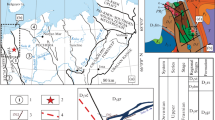Summary
Anhydrous iron, aluminum and fluorine-rich paralavas were found in the burned spoil-heaps of the Chelyabinsk coal basin, Russia. The rocks contain tridymite, anorthite, ferroan fluorine-bearing cordierite, fluorine-bearing mullite, periclase, fluorapatite, micas of the F-biotite–F-phlogopite series, fluortopaz, fluorite, and sellaite. The fluorine-rich minerals formed as a result of local thermal reactions of sedimentary carbonates and silicates with gaseous fluorine. During coal combustion fluorine concentrates in the annealed ankeritic marls where the increase of F is hundreds of times over its concentration in the initial sedimentary rocks. The formation of MgF2 and CaF2 promotes local melting at relatively low temperatures (T < 1000 °C) with the residuum consisting of two immiscible liquids. One crystallises as the fluorides, the other as fluorine-substituted analogues of the hydrosilicates, which under the extremely dry conditions, produce minerals containing extremely high F-contents.
Similar content being viewed by others
Author information
Authors and Affiliations
Additional information
Received April 10, 2000; revised version accepted February 24, 2001
Rights and permissions
About this article
Cite this article
Sokol, E., Nigmatulina, E. & Volkova, N. Fluorine mineralisation from burning coal spoil-heaps in the Russian Urals. Mineralogy and Petrology 75, 23–40 (2002). https://doi.org/10.1007/s007100200013
Issue Date:
DOI: https://doi.org/10.1007/s007100200013




